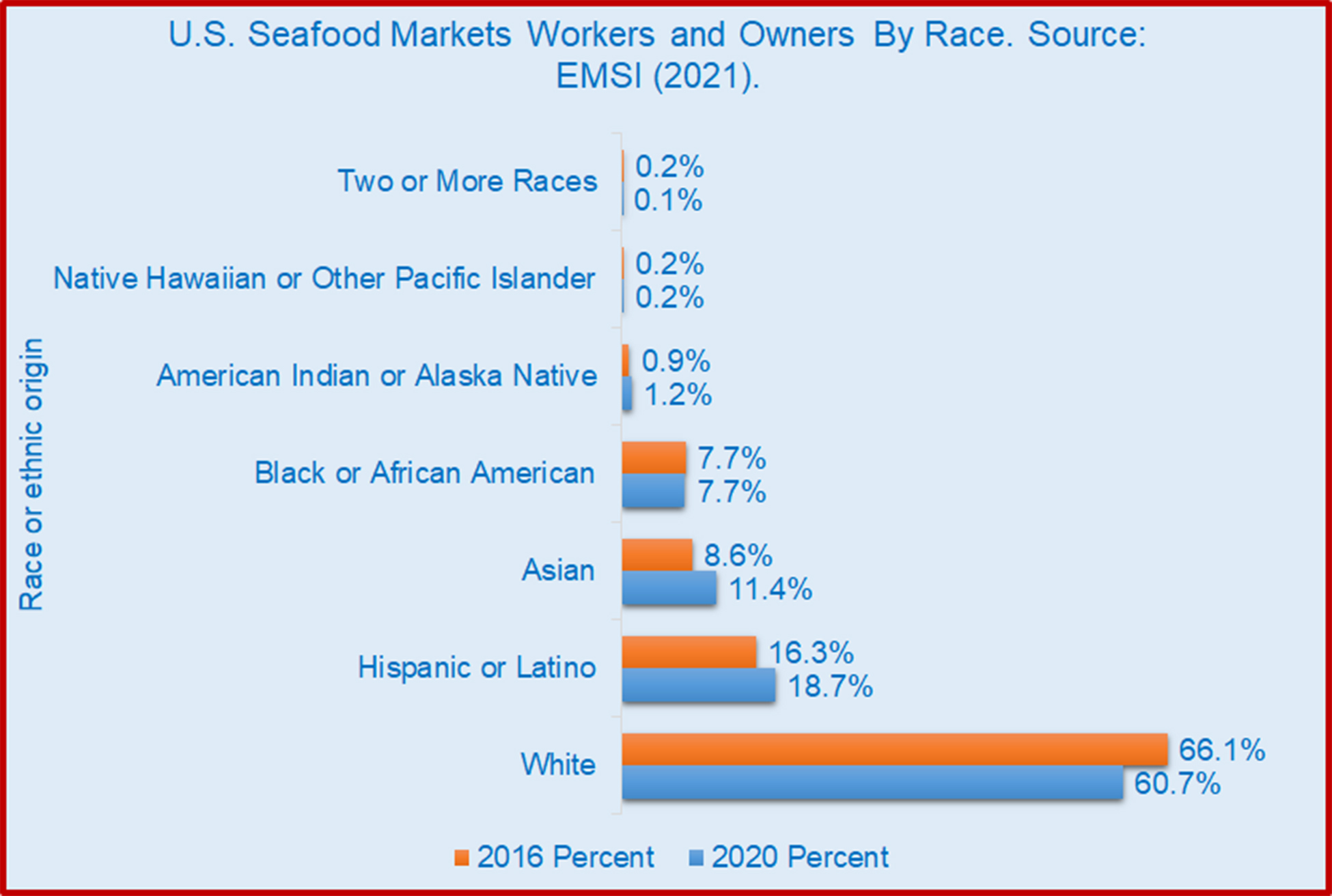Vol. 11, No. 8 / Seafood and Fish Markets in the United States and Gulf of Mexico Region
Abstract
In this issue, Dr. Posadas compiled and summarized the economic contributions of fish and seafood markets in the entire U.S. and Gulf regional economies. The trends in the number, wages, salaries, and earnings of workers and owners of fish and seafood markets are presented. The socioeconomic characteristics of workers and owners in 2016 and 2020 are compared. These long-term data on fish and seafood markets illustrate the significance of the industry in the national and Gulf economies.
Keywords
Fish and seafood markets; economic contributions; jobs and wages, salaries, and earnings; socioeconomic characteristics; workers and owners
Acknowledgement
This newsletter is a contribution of the Mississippi Agricultural and Forestry Experiment Station and the Mississippi State University Extension Service. This material is based upon work that is supported in part by the National Institute of Food and Agriculture, U.S. Department of Agriculture, Hatch project under accession number 081730 and NOAA (Office of Sea Grant, U.S. Dept. of Commerce, under Grant NA10OAR4170078, Mississippi Alabama Sea Grant Consortium).
Economic Contributions of Seafood and Fish Markets
An economic contribution measures the gross change in economic activity associated with an industry, event, or policy in an existing regional economy. This newsletter presents two types of economic contributions – employment or jobs and output or sales. The output or sales contributions are expressed in dollars for a specified year. Employment or jobs contributions are expressed in terms of a mix of both full-time and part-time employment.
During the past seven years, the annual contributions of the industry averaged $6.0 billion in sales and more than 90,000 jobs (Fig. 1). However, these data are over three years old. No recent updates are currently available from NOAA Fisheries.

U.S. Seafood and Fish Markets' Gross Regional Product
The gross regional product (GRP), also called regional gross domestic product (GDP), is the market value of all goods and services produced within a given area over a specific period and is a good measure of the size, income, and productivity of a regional economy (EMSI, 2021). The GRP of the seafood and fish markets reached over $1.0 billion per year during recent years (Fig 2).

The empirical relationship between sales contribution (S.C.) and gross regional product (GRP) was imputed from Figures 1 and 2. The SC-GRP ratio from 2011 to 2017 averaged 6.9:1.0. With this SC-GRP ratio, we estimated the annual sales contribution of the seafood and fish markets to exceed $7.0 billion in recent years.
Seafood and Fish Markets' Employment and Wages, Salaries, and Earnings
The fish and seafood markets (NAICS code 445220) industry comprise of establishments primarily engaged in retailing fresh, frozen, or cured fish and seafood products (U.S. Bureau of Census. https://www.census.gov/naics/).
The industry directly provided about 18,000 jobs per year in the U.S. during the past decade (Fig. 3). The five Gulf of Mexico states (A.L., FL, LA, MS, and TX) contributed about 22 percent of the jobs during the same period.

The combined wages, salaries, and proprietor earnings of all the QCEW employees, non-QCEW employees, self-employed, and extended proprietors averaged $32,000 per person in the past decade (Fig. 4).
The annual pay of workers and owners of these businesses in the five Gulf of Mexico States averaged almost $25,700 per person or 79 percent of the national average.

In summary, the economic indicators shown above indicated that the seafood and fish markets in the entire U.S. and the Gulf of Mexico States were growing during the past decade. However, the Covid-19 global pandemic undoubtedly caused a significant decline in workers' and owners' sales, jobs, and incomes in 2020.
Distribution of Seafood and Fish Markets' Employees and Owners by Gender
The 2020 industrial overview released by EMSI (April 2021) showed that approximately 46.6 percent were males (Table 1). About 53.4 percent of the workers and owners were females. In the Gulf States, 45.6 percent are males, while 54.4 percent are females.


The proportion of male workers and owners of seafood and fish markets decreased from 54 to 47 percent from 2016 to 2020 in the entire industry (Fig. 5). There were more women workers and owners in 2020 compared to 2016.
Distribution of Seafood and Fish Markets' Employees and Owners by Race or Ethnicity
The 2020 industrial overview disseminated by EMSI (April 2021) also categorized the workers and owners by race or ethnicity (Table 2). Most of the workers are White (60%), followed by Hispanic (19%), Asian (11%), and African American (8%). The rest are with two or more races (1.2%), Native Hawaiian (0.2%), and American Indian (0.1%).
In the Gulf States, relatively more Hispanic and African American workers and owners are involved in the industry. Fewer White and Asian workers and owners are engaged in the industry in the Gulf States.

Relatively higher percentages of workers and owners were observed among Hispanic and Asian workers and owners in 2020 (Fig. 6). Lower proportions were detected among White and African American workers and owners in 2020.

Distribution of Seafood and Fish Markets' Employees and Owners by Age
The 2020 industrial overview published by EMSI (April 2021) also classified the workers and owners by age (Table 3). About 7.6 percent of the workers and owners are 65 years old and above. Around 18.1 percent of the workers and owners were 55-64 years old. The 45-54 years old group added 21.1 percent. Approximately 16.1 percent belonged to the 35-44 years old group. The 25-34 years old added 17.4 percent. Younger employees and owners comprised the rest.
Workers and owners in the Gulf States are of similar ages as the national average. U.S and Gulf workers and owners averaged 41.7 years old.


My Seafood and Fish Markets' Economics Outreach
- Posadas, B.C. Seafood and Fish Markets in the United States and Gulf of Mexico Region. Mississippi MarketMaker Newsletter, Vol. 11, No. 8. August 10, 2021. http://extension.msstate.edu/newsletters/mississippi-marketmaker.
- Posadas, B.C. Economic Impacts of the Global Covid-19 Pandemic on U.S. Retail Prices of Selected Shellfish Species. Mississippi MarketMaker Newsletter, Vol. 11, No. 1. January 6, 2021. http://extension.msstate.edu/newsletters/mississippi-marketmaker.
- Posadas, B. C. Economic Impacts of the Global Covid-19 Pandemic on U.S. Retail Prices of Selected Shellfish Species," Mississippi State University, Coastal Research and Extension Center, Virtual Presentation. (January 5, 2021). https://www.youtube.com/playlist?list=PLB0D9oT09EZIQGjeX6QSBg-Lk5QQfeJ6m.
- Posadas, B.C. Economic Impacts of the Global Covid-19 Pandemic on U.S. Retail Prices of Selected Fish Species. Mississippi MarketMaker Newsletter, Vol. 10, No. 11. December 8, 2020. http://extension.msstate.edu/newsletters/mississippi-marketmaker.
- Posadas, B. C. Economic Impacts of the Global Covid-19 Pandemic on U.S. Retail Prices of Selected Fish Species," Mississippi State University, Coastal Research and Extension Center, Virtual Presentation. (December 8, 2020). https://www.youtube.com/playlist?list=PLB0D9oT09EZIQGjeX6QSBg-Lk5QQfeJ6m.
- Posadas, B.C. Economic Contribution of Fish and Seafood Markets in Coastal Mississippi. Mississippi MarketMaker Newsletter, Vol. 9, No. 11. November 5, 2019. http://extension.msstate.edu/newsletters/mississippi-marketmaker.
- Posadas, B.C. Fish and Seafood Markets Employment and Incomes in the Gulf of Mexico and the United States. Mississippi MarketMaker Newsletter, Vol. 7, No. 22, November 30, 2017.
Suggested Citation
Posadas, B.C. Seafood and Fish Markets in the United States and Gulf of Mexico Region. Mississippi MarketMaker Newsletter, Vol. 11, No. 8. August 10, 2021. http://extension.msstate.edu/newsletters/mississippi-marketmaker.









